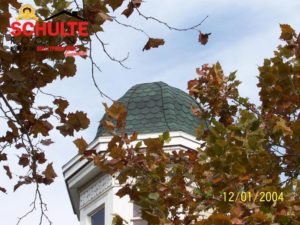One type of plant life that plagues many types of roofs is moss or bryophyte. According to professional roofers, although it is mostly considered an aesthetic problem, bryophyte actually poses a more serious threat than meets the eye. The following is a closer look at what kind of damage this type of plant life can inflict on a roof and how homeowners can address the problem.
roofers, although it is mostly considered an aesthetic problem, bryophyte actually poses a more serious threat than meets the eye. The following is a closer look at what kind of damage this type of plant life can inflict on a roof and how homeowners can address the problem.
Damage
Moss may seem like an innocent plant life that does nothing more than alter the color of the roof. Although the dark stain it leaves is an eyesore, usually no action is taken because it is mistakenly believed that discoloration is the only damage bryophyte causes. In reality, there are a myriad of problems that moss can inflict on a housetop.
Microscopically, the plant is composed of tiny leaves and roots. Its fine and thick leaf-like structure is capable of harboring water from any run-off and even condensation from cold air. A roof plagued with moss deteriorates much faster due to the fact that it is exposed to water longer than normal. The bryophyte prevents water from evaporating and instead stores it for its survival.
The root of the plant also amplifies its capability to create damage. Like any other plant life, moss is equipped with fine roots that gain a foothold on the roof that seek out nutrients to supply the rest of its parts. The problem is that the root structure is capable of creating small cracks in the roofing material. As it grows, the roots also sink deeper into the material, reducing its structural strength. In freezing climates, bryophyte can cause extensive frost damage and cracking.
Remedies
If a roof is beginning to show signs of a moss infestation, it may not necessarily be too late to halt the resulting damage. It is relatively easy to stop this infestation since the presence of bryophyte is easily visible. Protecting the roof is dealing with getting rid of the plant life before it begins to thrive and does indeed cause serious roof damage.
The first step in getting rid of moss is to inspect the roof for any plant life, including moss. Inspections should be performed once every season. Look for any discoloration that would indicate that spores are beginning to take hold. Bryophyte usually thrives on the parts of a roof that are shaded by tree branches or overhead structures and are frequently wet. Gutters are also another place for moss to thrive, especially if they are clogged.
The second stop is to eliminate the moss. Three different methods can be used:
- Scraping – One simple removal method is to scrape or brush it off; however, it is important to not damage the finish of the roof in the process. Power washing should not be used as a means of removal of bryophyte as high-pressured water has the potential to damage the entire structure.
- Spraying – Another method of getting rid of a severe moss infestation is by spraying it with a cleaning solution. A more inexpensive method of mixing water with bleach will also have the same result; just do not forget to rinse it with plain water to prevent staining.
- Zinc or Copper Strip – If the moss infestation is so severe that it cannot be managed with regular cleaning, professional roofers use the simple trick of installing a zinc or copper strip between the shingles to provide a long-lasting solution. The molecules from the strip will wash off when it rains and will kill off bryophyte and any other plant life that may be growing.
Bryophyte and other foreign plant life are not healthy for a roof, unless it is has been built to be a “green” structure. Moss is not just an eye sore; it can actually lead to extensive damage and costly repairs. So always remember that moss on a roof is definitely not a good idea!
Are you looking for a Houston roofer to handle work on your roof? Schulte Roofing of Navasota serves the greater Houston area and can help all Houston customers with their roofing problems!
